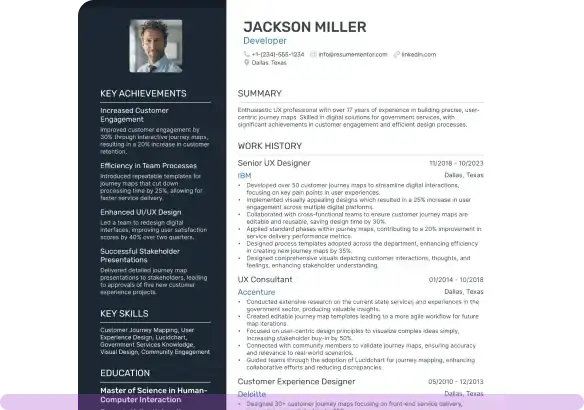Allergist Resume Examples

Jul 18, 2024
|
12 min read
Navigating the path to you being an allergist: crafting a resume that's a breath of fresh air
Rated by 348 people
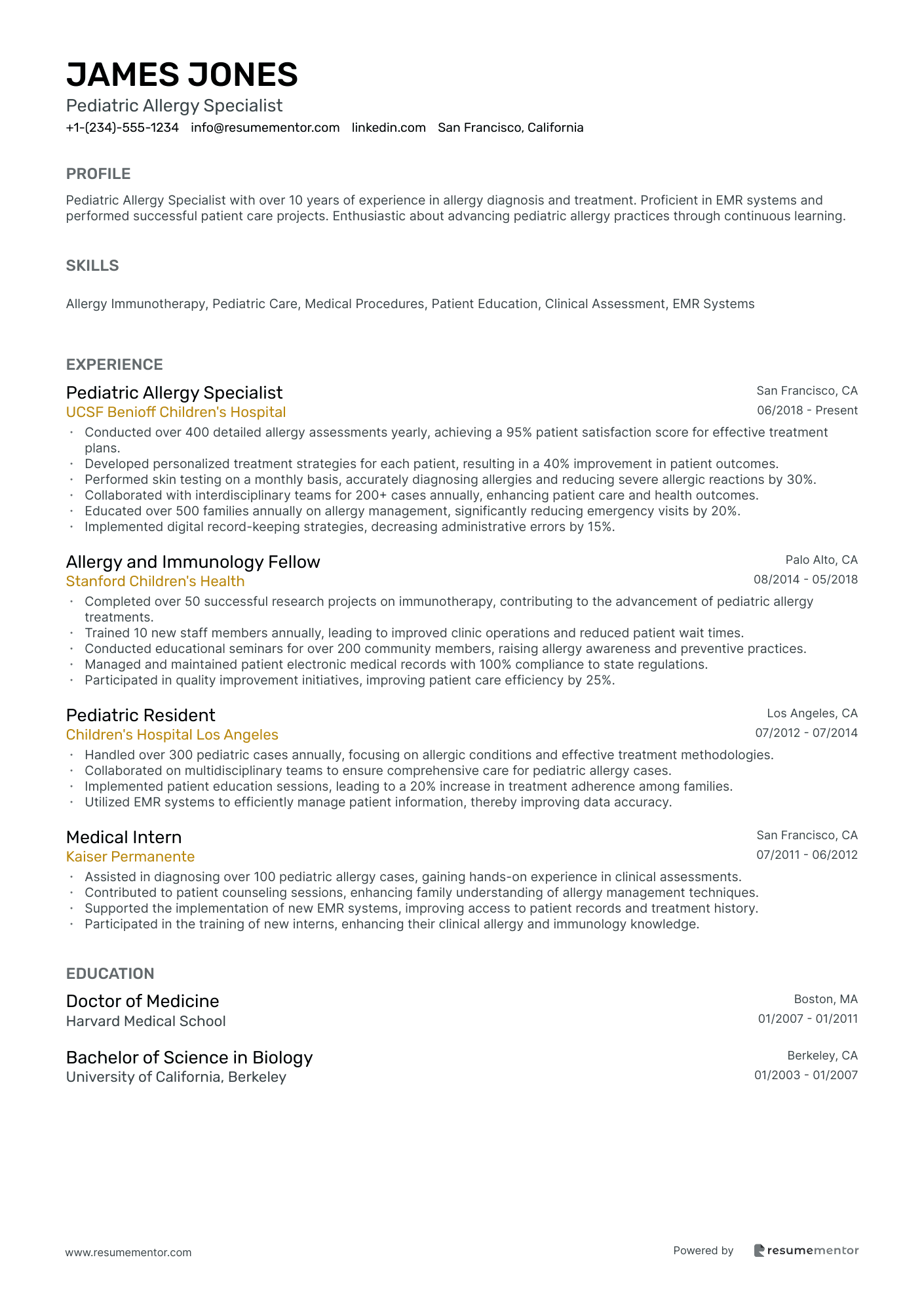
Pediatric Allergy Specialist
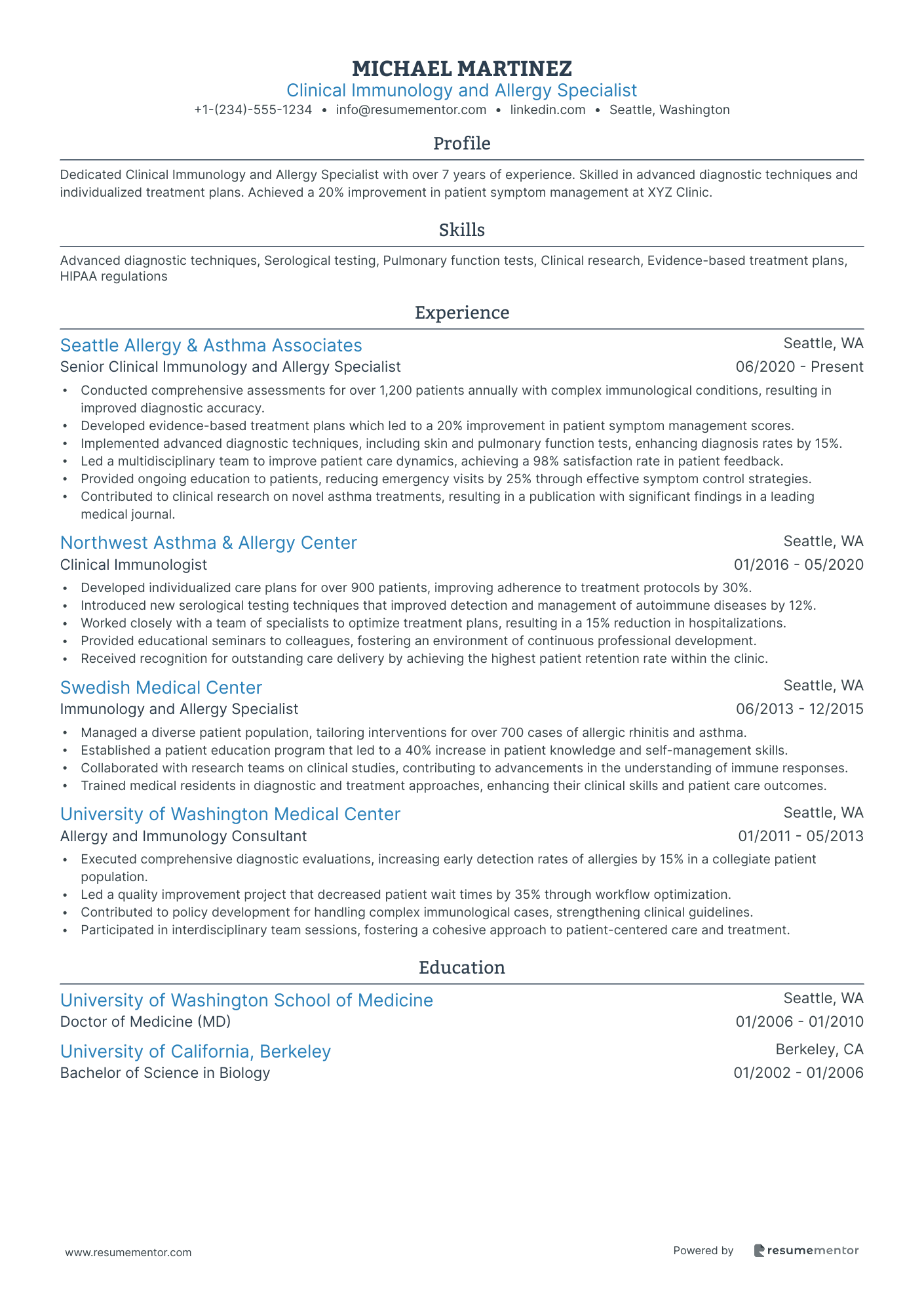
Clinical Immunology and Allergy Specialist
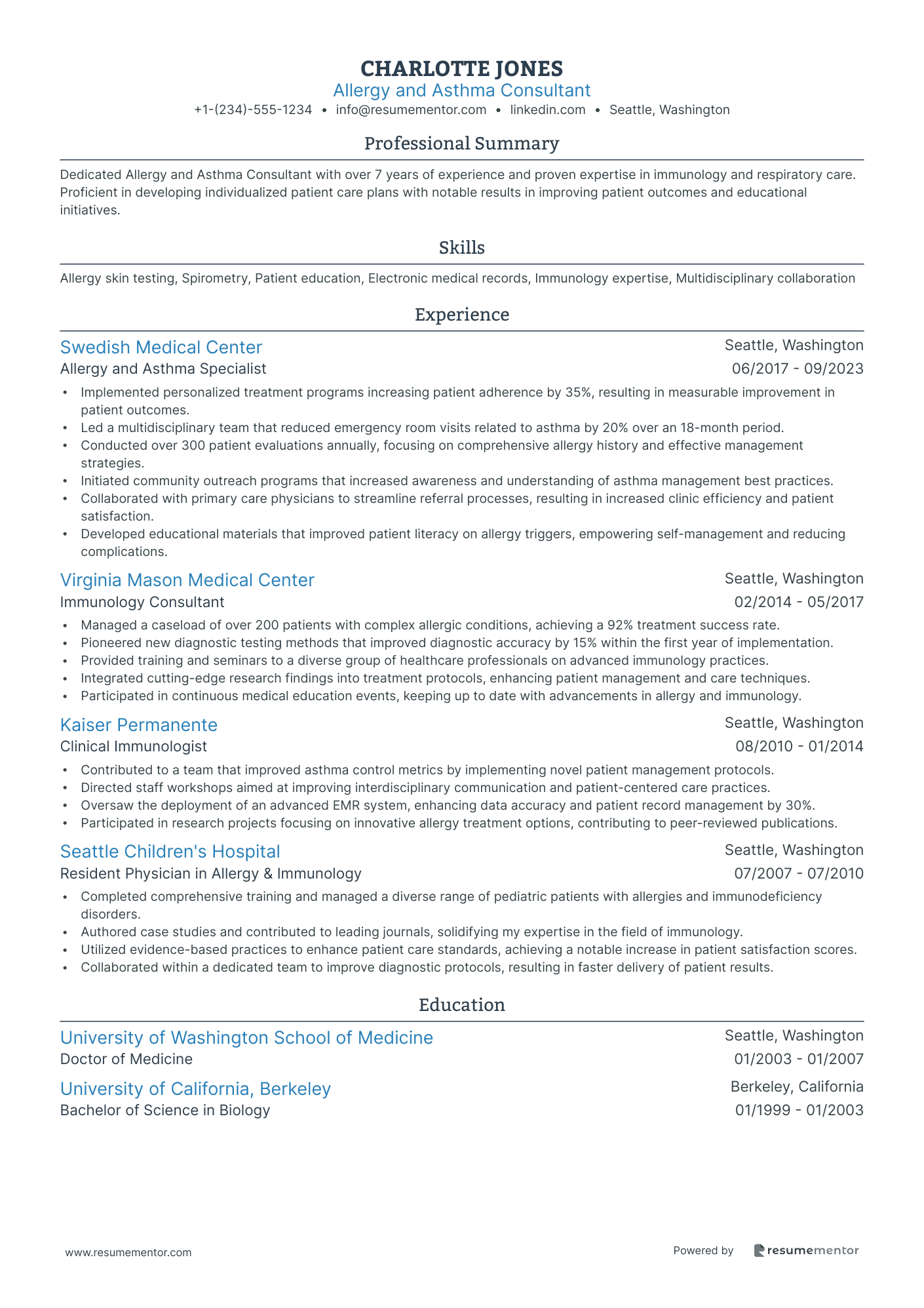
Allergy and Asthma Consultant
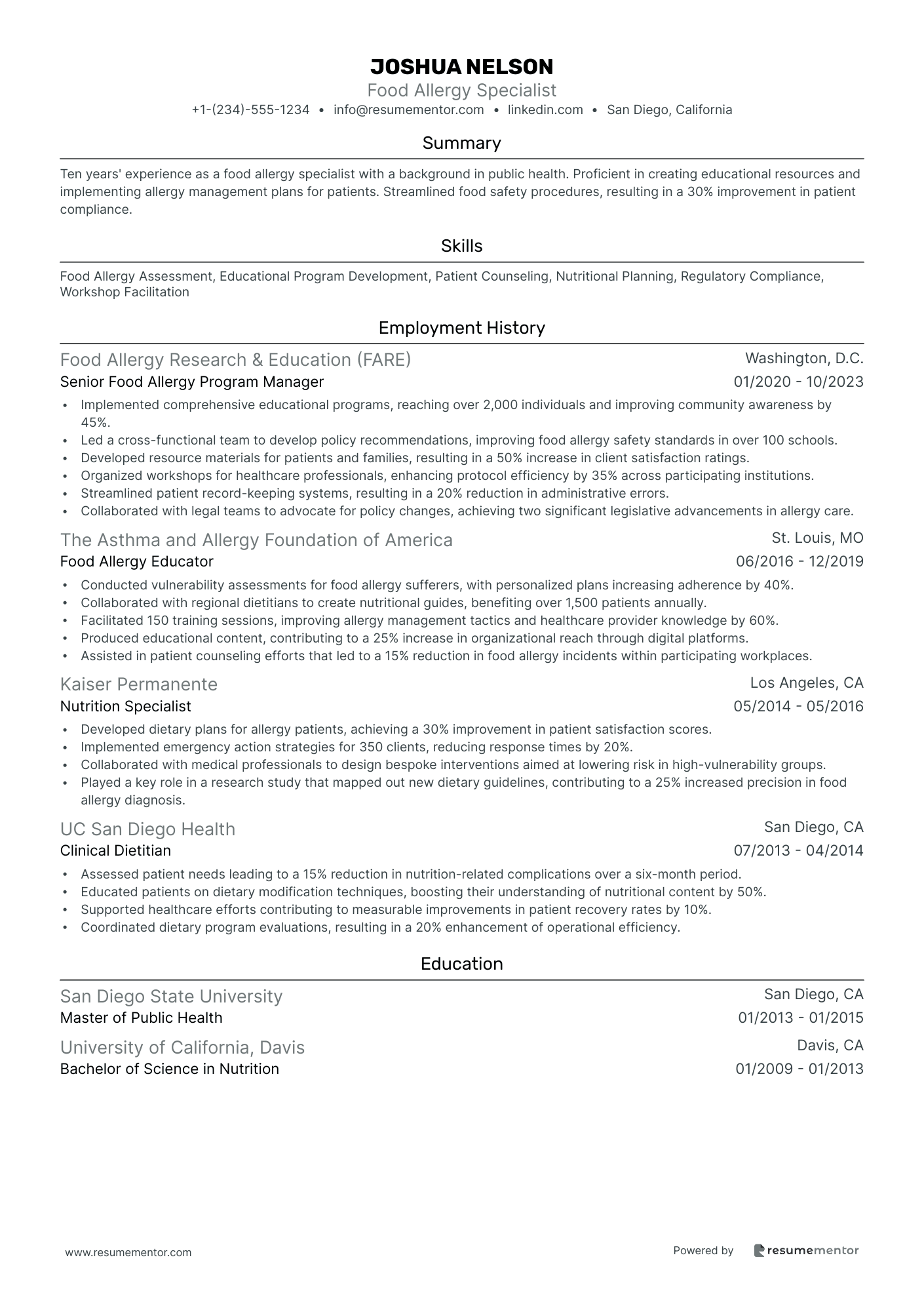
Food Allergy Specialist
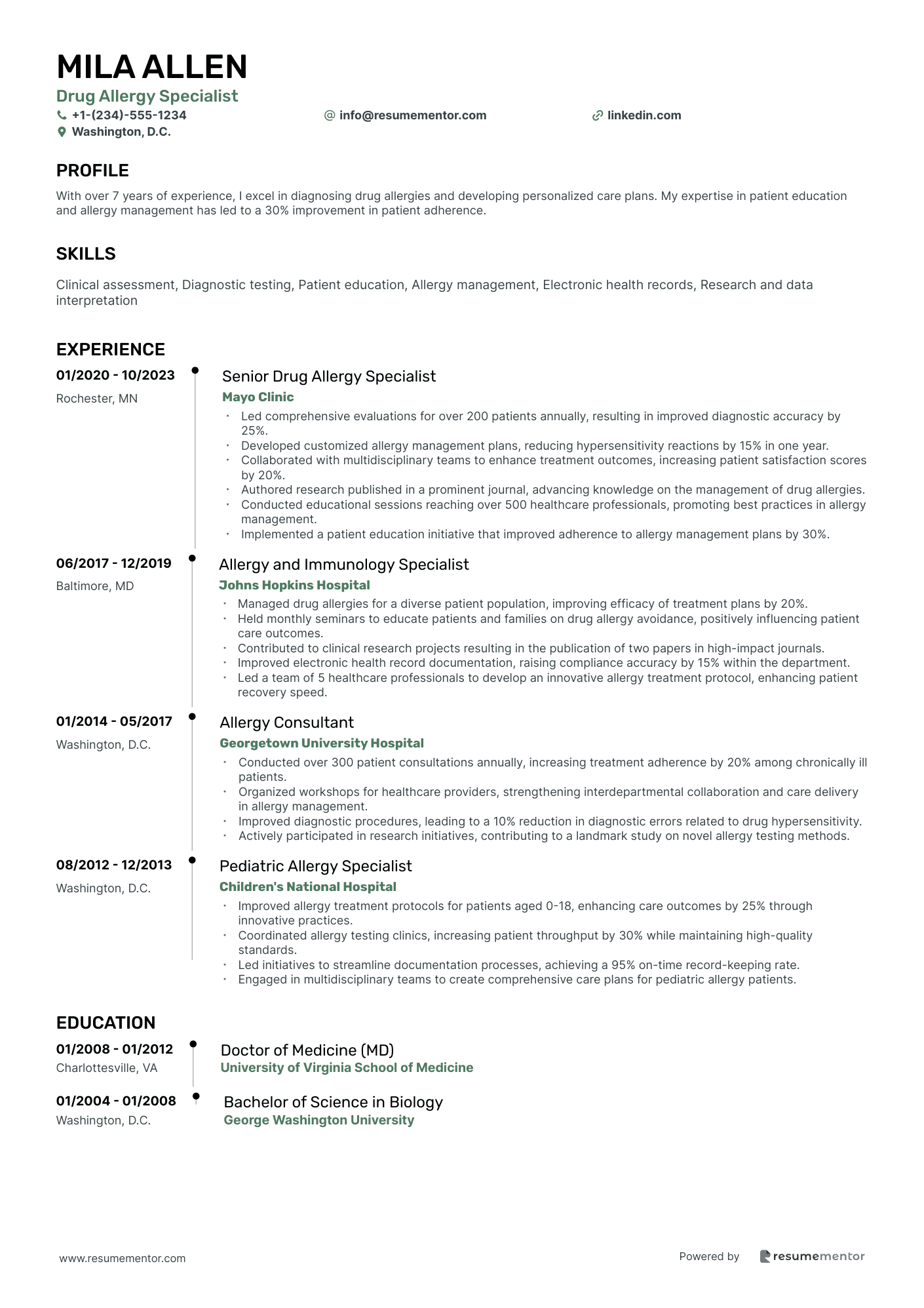
Drug Allergy Specialist
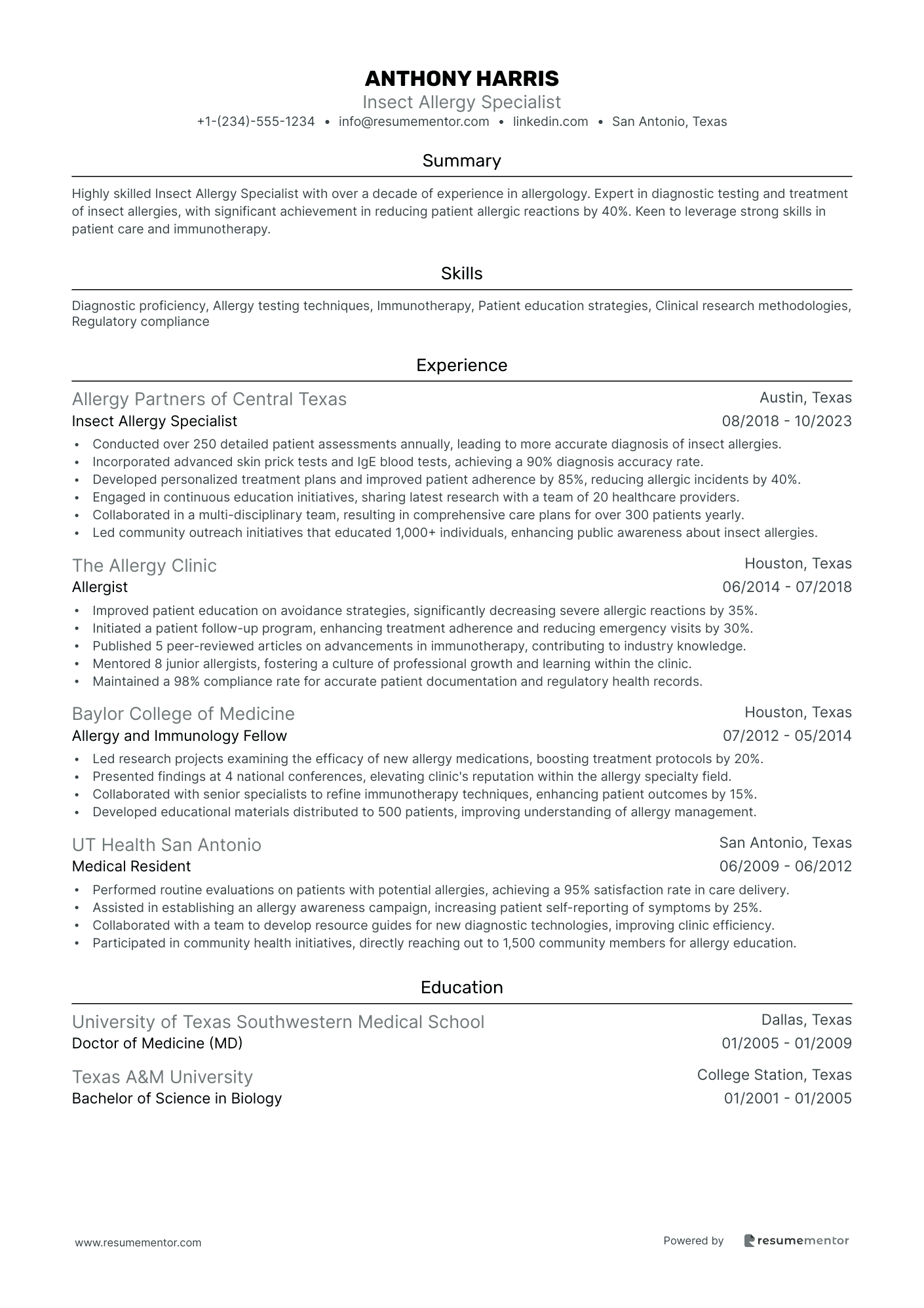
Insect Allergy Specialist
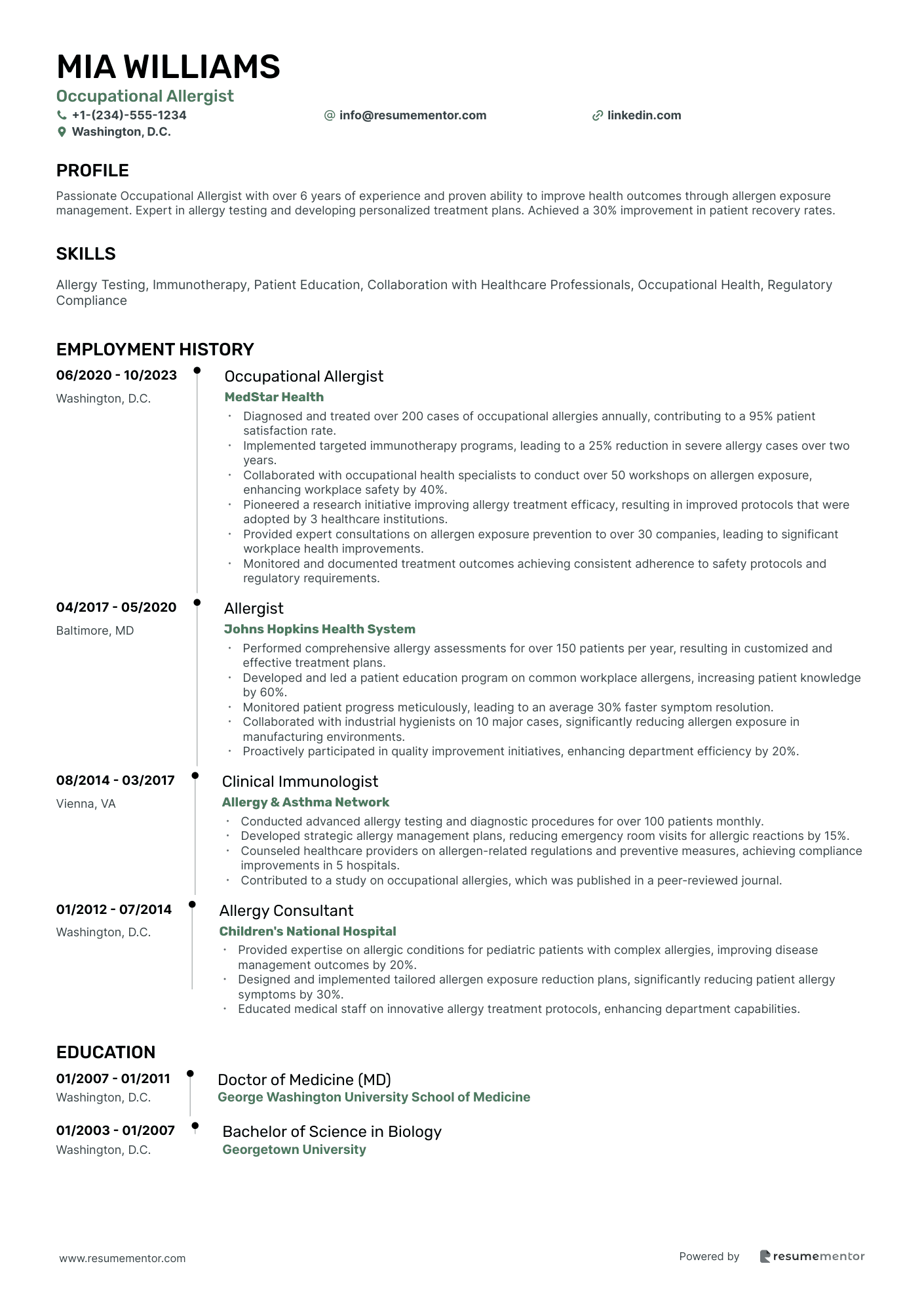
Occupational Allergist
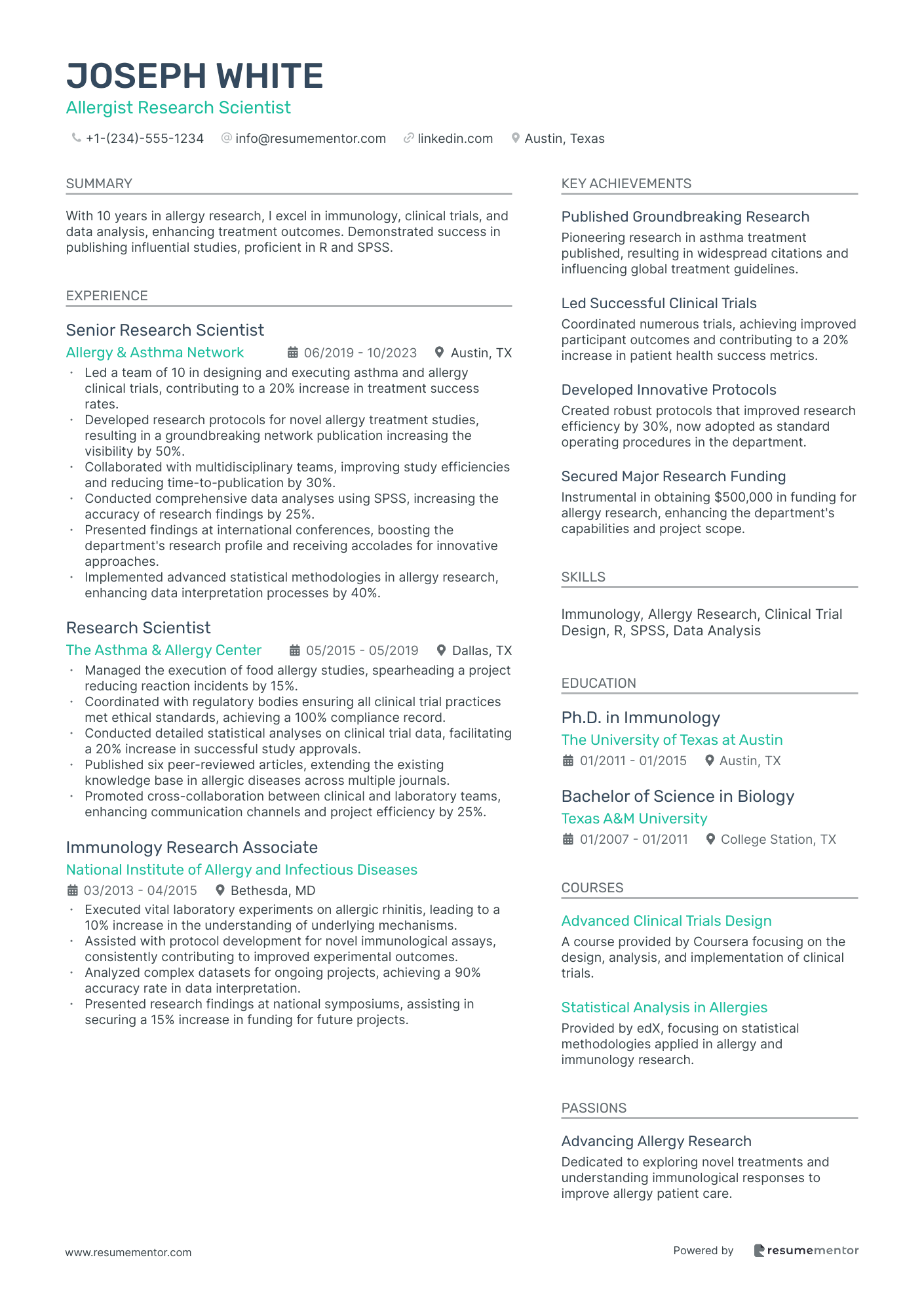
Allergist Research Scientist
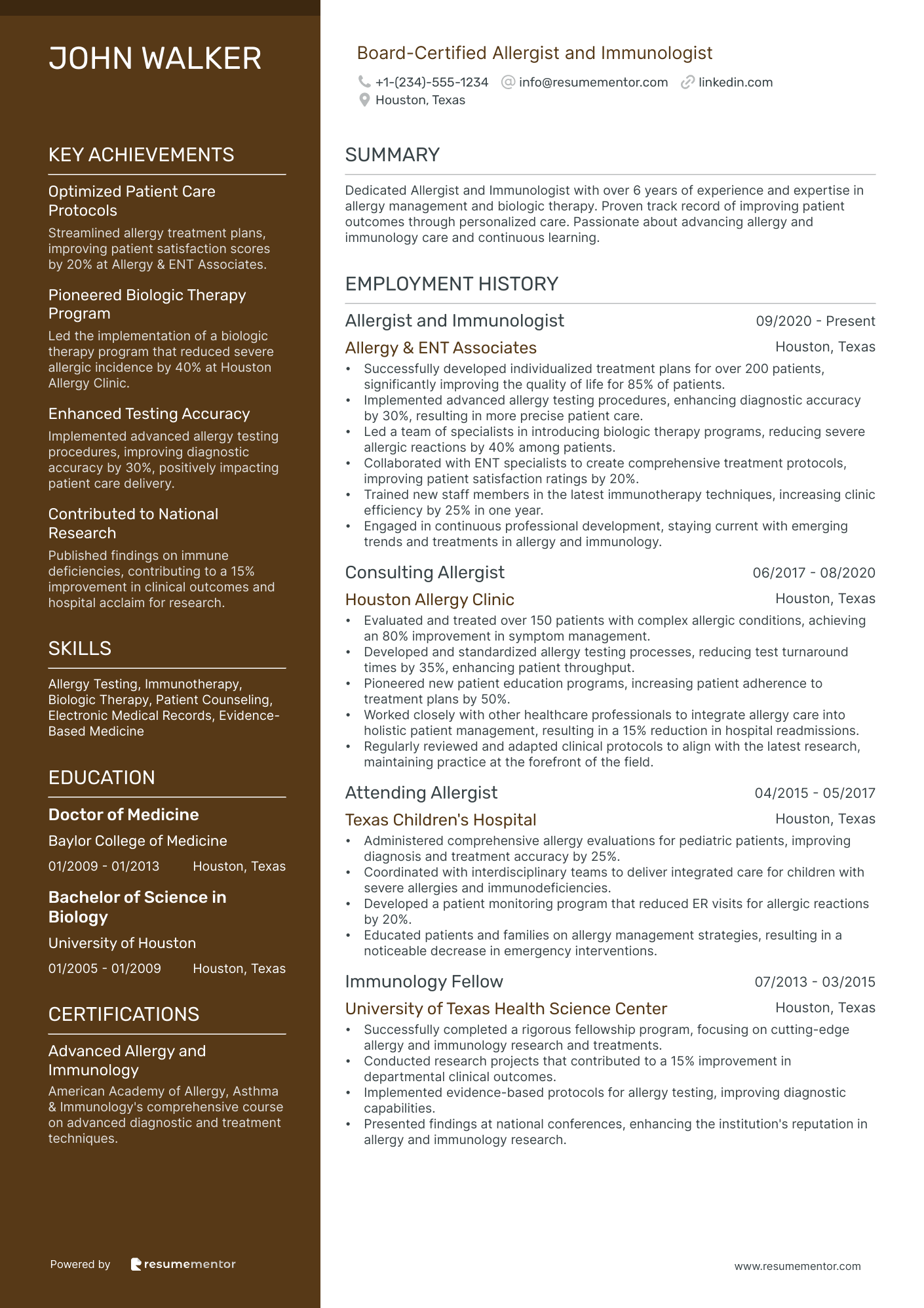
Board-Certified Allergist and Immunologist
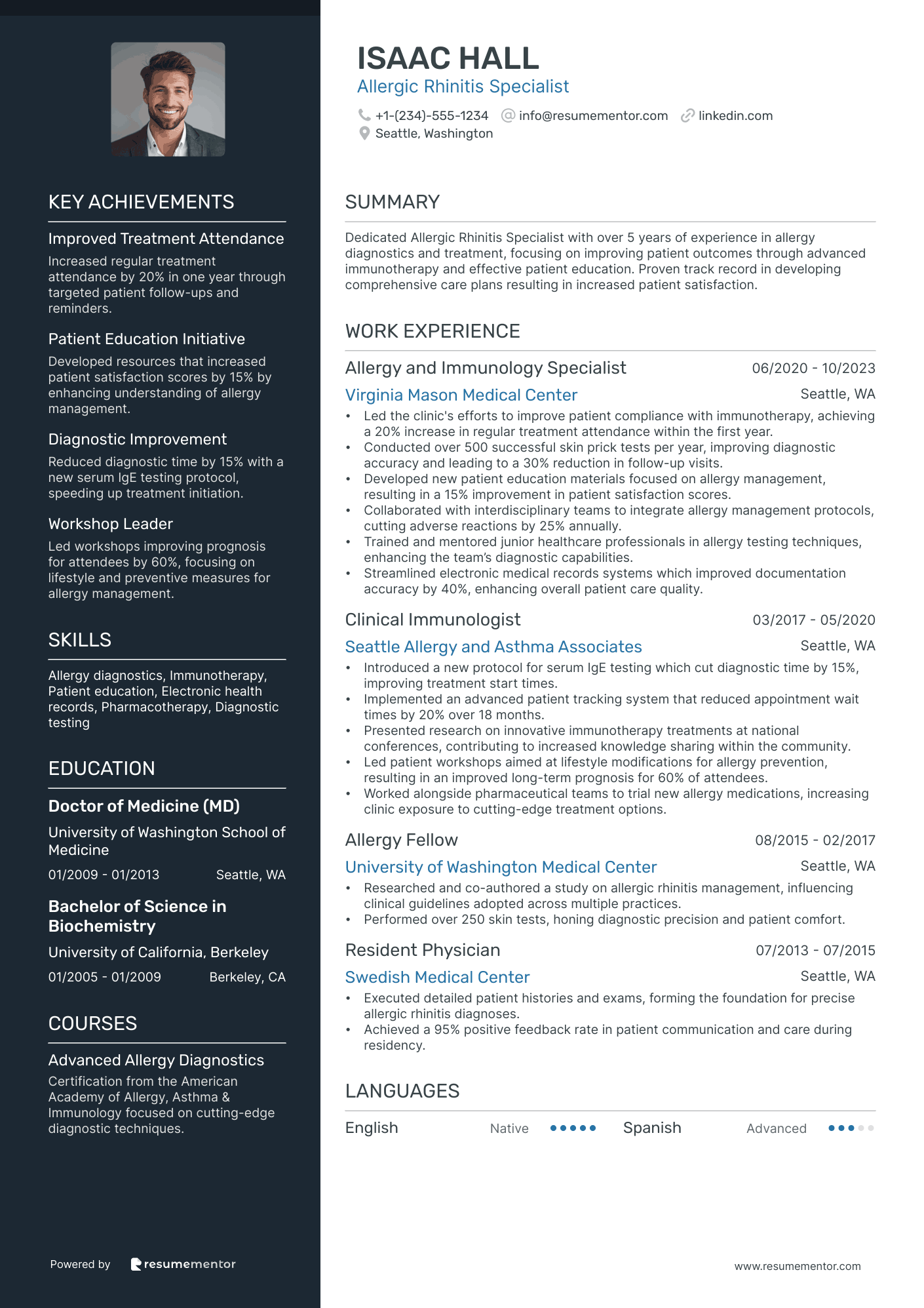
Allergic Rhinitis Specialist

Pediatric Allergy Specialist resume sample
- •Conducted over 400 detailed allergy assessments yearly, achieving a 95% patient satisfaction score for effective treatment plans.
- •Developed personalized treatment strategies for each patient, resulting in a 40% improvement in patient outcomes.
- •Performed skin testing on a monthly basis, accurately diagnosing allergies and reducing severe allergic reactions by 30%.
- •Collaborated with interdisciplinary teams for 200+ cases annually, enhancing patient care and health outcomes.
- •Educated over 500 families annually on allergy management, significantly reducing emergency visits by 20%.
- •Implemented digital record-keeping strategies, decreasing administrative errors by 15%.
- •Completed over 50 successful research projects on immunotherapy, contributing to the advancement of pediatric allergy treatments.
- •Trained 10 new staff members annually, leading to improved clinic operations and reduced patient wait times.
- •Conducted educational seminars for over 200 community members, raising allergy awareness and preventive practices.
- •Managed and maintained patient electronic medical records with 100% compliance to state regulations.
- •Participated in quality improvement initiatives, improving patient care efficiency by 25%.
- •Handled over 300 pediatric cases annually, focusing on allergic conditions and effective treatment methodologies.
- •Collaborated on multidisciplinary teams to ensure comprehensive care for pediatric allergy cases.
- •Implemented patient education sessions, leading to a 20% increase in treatment adherence among families.
- •Utilized EMR systems to efficiently manage patient information, thereby improving data accuracy.
- •Assisted in diagnosing over 100 pediatric allergy cases, gaining hands-on experience in clinical assessments.
- •Contributed to patient counseling sessions, enhancing family understanding of allergy management techniques.
- •Supported the implementation of new EMR systems, improving access to patient records and treatment history.
- •Participated in the training of new interns, enhancing their clinical allergy and immunology knowledge.
Clinical Immunology and Allergy Specialist resume sample
- •Conducted comprehensive assessments for over 1,200 patients annually with complex immunological conditions, resulting in improved diagnostic accuracy.
- •Developed evidence-based treatment plans which led to a 20% improvement in patient symptom management scores.
- •Implemented advanced diagnostic techniques, including skin and pulmonary function tests, enhancing diagnosis rates by 15%.
- •Led a multidisciplinary team to improve patient care dynamics, achieving a 98% satisfaction rate in patient feedback.
- •Provided ongoing education to patients, reducing emergency visits by 25% through effective symptom control strategies.
- •Contributed to clinical research on novel asthma treatments, resulting in a publication with significant findings in a leading medical journal.
- •Developed individualized care plans for over 900 patients, improving adherence to treatment protocols by 30%.
- •Introduced new serological testing techniques that improved detection and management of autoimmune diseases by 12%.
- •Worked closely with a team of specialists to optimize treatment plans, resulting in a 15% reduction in hospitalizations.
- •Provided educational seminars to colleagues, fostering an environment of continuous professional development.
- •Received recognition for outstanding care delivery by achieving the highest patient retention rate within the clinic.
- •Managed a diverse patient population, tailoring interventions for over 700 cases of allergic rhinitis and asthma.
- •Established a patient education program that led to a 40% increase in patient knowledge and self-management skills.
- •Collaborated with research teams on clinical studies, contributing to advancements in the understanding of immune responses.
- •Trained medical residents in diagnostic and treatment approaches, enhancing their clinical skills and patient care outcomes.
- •Executed comprehensive diagnostic evaluations, increasing early detection rates of allergies by 15% in a collegiate patient population.
- •Led a quality improvement project that decreased patient wait times by 35% through workflow optimization.
- •Contributed to policy development for handling complex immunological cases, strengthening clinical guidelines.
- •Participated in interdisciplinary team sessions, fostering a cohesive approach to patient-centered care and treatment.
Allergy and Asthma Consultant resume sample
- •Implemented personalized treatment programs increasing patient adherence by 35%, resulting in measurable improvement in patient outcomes.
- •Led a multidisciplinary team that reduced emergency room visits related to asthma by 20% over an 18-month period.
- •Conducted over 300 patient evaluations annually, focusing on comprehensive allergy history and effective management strategies.
- •Initiated community outreach programs that increased awareness and understanding of asthma management best practices.
- •Collaborated with primary care physicians to streamline referral processes, resulting in increased clinic efficiency and patient satisfaction.
- •Developed educational materials that improved patient literacy on allergy triggers, empowering self-management and reducing complications.
- •Managed a caseload of over 200 patients with complex allergic conditions, achieving a 92% treatment success rate.
- •Pioneered new diagnostic testing methods that improved diagnostic accuracy by 15% within the first year of implementation.
- •Provided training and seminars to a diverse group of healthcare professionals on advanced immunology practices.
- •Integrated cutting-edge research findings into treatment protocols, enhancing patient management and care techniques.
- •Participated in continuous medical education events, keeping up to date with advancements in allergy and immunology.
- •Contributed to a team that improved asthma control metrics by implementing novel patient management protocols.
- •Directed staff workshops aimed at improving interdisciplinary communication and patient-centered care practices.
- •Oversaw the deployment of an advanced EMR system, enhancing data accuracy and patient record management by 30%.
- •Participated in research projects focusing on innovative allergy treatment options, contributing to peer-reviewed publications.
- •Completed comprehensive training and managed a diverse range of pediatric patients with allergies and immunodeficiency disorders.
- •Authored case studies and contributed to leading journals, solidifying my expertise in the field of immunology.
- •Utilized evidence-based practices to enhance patient care standards, achieving a notable increase in patient satisfaction scores.
- •Collaborated within a dedicated team to improve diagnostic protocols, resulting in faster delivery of patient results.
Food Allergy Specialist resume sample
- •Implemented comprehensive educational programs, reaching over 2,000 individuals and improving community awareness by 45%.
- •Led a cross-functional team to develop policy recommendations, improving food allergy safety standards in over 100 schools.
- •Developed resource materials for patients and families, resulting in a 50% increase in client satisfaction ratings.
- •Organized workshops for healthcare professionals, enhancing protocol efficiency by 35% across participating institutions.
- •Streamlined patient record-keeping systems, resulting in a 20% reduction in administrative errors.
- •Collaborated with legal teams to advocate for policy changes, achieving two significant legislative advancements in allergy care.
- •Conducted vulnerability assessments for food allergy sufferers, with personalized plans increasing adherence by 40%.
- •Collaborated with regional dietitians to create nutritional guides, benefiting over 1,500 patients annually.
- •Facilitated 150 training sessions, improving allergy management tactics and healthcare provider knowledge by 60%.
- •Produced educational content, contributing to a 25% increase in organizational reach through digital platforms.
- •Assisted in patient counseling efforts that led to a 15% reduction in food allergy incidents within participating workplaces.
- •Developed dietary plans for allergy patients, achieving a 30% improvement in patient satisfaction scores.
- •Implemented emergency action strategies for 350 clients, reducing response times by 20%.
- •Collaborated with medical professionals to design bespoke interventions aimed at lowering risk in high-vulnerability groups.
- •Played a key role in a research study that mapped out new dietary guidelines, contributing to a 25% increased precision in food allergy diagnosis.
- •Assessed patient needs leading to a 15% reduction in nutrition-related complications over a six-month period.
- •Educated patients on dietary modification techniques, boosting their understanding of nutritional content by 50%.
- •Supported healthcare efforts contributing to measurable improvements in patient recovery rates by 10%.
- •Coordinated dietary program evaluations, resulting in a 20% enhancement of operational efficiency.
Drug Allergy Specialist resume sample
- •Led comprehensive evaluations for over 200 patients annually, resulting in improved diagnostic accuracy by 25%.
- •Developed customized allergy management plans, reducing hypersensitivity reactions by 15% in one year.
- •Collaborated with multidisciplinary teams to enhance treatment outcomes, increasing patient satisfaction scores by 20%.
- •Authored research published in a prominent journal, advancing knowledge on the management of drug allergies.
- •Conducted educational sessions reaching over 500 healthcare professionals, promoting best practices in allergy management.
- •Implemented a patient education initiative that improved adherence to allergy management plans by 30%.
- •Managed drug allergies for a diverse patient population, improving efficacy of treatment plans by 20%.
- •Held monthly seminars to educate patients and families on drug allergy avoidance, positively influencing patient care outcomes.
- •Contributed to clinical research projects resulting in the publication of two papers in high-impact journals.
- •Improved electronic health record documentation, raising compliance accuracy by 15% within the department.
- •Led a team of 5 healthcare professionals to develop an innovative allergy treatment protocol, enhancing patient recovery speed.
- •Conducted over 300 patient consultations annually, increasing treatment adherence by 20% among chronically ill patients.
- •Organized workshops for healthcare providers, strengthening interdepartmental collaboration and care delivery in allergy management.
- •Improved diagnostic procedures, leading to a 10% reduction in diagnostic errors related to drug hypersensitivity.
- •Actively participated in research initiatives, contributing to a landmark study on novel allergy testing methods.
- •Improved allergy treatment protocols for patients aged 0-18, enhancing care outcomes by 25% through innovative practices.
- •Coordinated allergy testing clinics, increasing patient throughput by 30% while maintaining high-quality standards.
- •Led initiatives to streamline documentation processes, achieving a 95% on-time record-keeping rate.
- •Engaged in multidisciplinary teams to create comprehensive care plans for pediatric allergy patients.
Insect Allergy Specialist resume sample
- •Conducted over 250 detailed patient assessments annually, leading to more accurate diagnosis of insect allergies.
- •Incorporated advanced skin prick tests and IgE blood tests, achieving a 90% diagnosis accuracy rate.
- •Developed personalized treatment plans and improved patient adherence by 85%, reducing allergic incidents by 40%.
- •Engaged in continuous education initiatives, sharing latest research with a team of 20 healthcare providers.
- •Collaborated in a multi-disciplinary team, resulting in comprehensive care plans for over 300 patients yearly.
- •Led community outreach initiatives that educated 1,000+ individuals, enhancing public awareness about insect allergies.
- •Improved patient education on avoidance strategies, significantly decreasing severe allergic reactions by 35%.
- •Initiated a patient follow-up program, enhancing treatment adherence and reducing emergency visits by 30%.
- •Published 5 peer-reviewed articles on advancements in immunotherapy, contributing to industry knowledge.
- •Mentored 8 junior allergists, fostering a culture of professional growth and learning within the clinic.
- •Maintained a 98% compliance rate for accurate patient documentation and regulatory health records.
- •Led research projects examining the efficacy of new allergy medications, boosting treatment protocols by 20%.
- •Presented findings at 4 national conferences, elevating clinic's reputation within the allergy specialty field.
- •Collaborated with senior specialists to refine immunotherapy techniques, enhancing patient outcomes by 15%.
- •Developed educational materials distributed to 500 patients, improving understanding of allergy management.
- •Performed routine evaluations on patients with potential allergies, achieving a 95% satisfaction rate in care delivery.
- •Assisted in establishing an allergy awareness campaign, increasing patient self-reporting of symptoms by 25%.
- •Collaborated with a team to develop resource guides for new diagnostic technologies, improving clinic efficiency.
- •Participated in community health initiatives, directly reaching out to 1,500 community members for allergy education.
Occupational Allergist resume sample
- •Diagnosed and treated over 200 cases of occupational allergies annually, contributing to a 95% patient satisfaction rate.
- •Implemented targeted immunotherapy programs, leading to a 25% reduction in severe allergy cases over two years.
- •Collaborated with occupational health specialists to conduct over 50 workshops on allergen exposure, enhancing workplace safety by 40%.
- •Pioneered a research initiative improving allergy treatment efficacy, resulting in improved protocols that were adopted by 3 healthcare institutions.
- •Provided expert consultations on allergen exposure prevention to over 30 companies, leading to significant workplace health improvements.
- •Monitored and documented treatment outcomes achieving consistent adherence to safety protocols and regulatory requirements.
- •Performed comprehensive allergy assessments for over 150 patients per year, resulting in customized and effective treatment plans.
- •Developed and led a patient education program on common workplace allergens, increasing patient knowledge by 60%.
- •Monitored patient progress meticulously, leading to an average 30% faster symptom resolution.
- •Collaborated with industrial hygienists on 10 major cases, significantly reducing allergen exposure in manufacturing environments.
- •Proactively participated in quality improvement initiatives, enhancing department efficiency by 20%.
- •Conducted advanced allergy testing and diagnostic procedures for over 100 patients monthly.
- •Developed strategic allergy management plans, reducing emergency room visits for allergic reactions by 15%.
- •Counseled healthcare providers on allergen-related regulations and preventive measures, achieving compliance improvements in 5 hospitals.
- •Contributed to a study on occupational allergies, which was published in a peer-reviewed journal.
- •Provided expertise on allergic conditions for pediatric patients with complex allergies, improving disease management outcomes by 20%.
- •Designed and implemented tailored allergen exposure reduction plans, significantly reducing patient allergy symptoms by 30%.
- •Educated medical staff on innovative allergy treatment protocols, enhancing department capabilities.
Allergist Research Scientist resume sample
- •Led a team of 10 in designing and executing asthma and allergy clinical trials, contributing to a 20% increase in treatment success rates.
- •Developed research protocols for novel allergy treatment studies, resulting in a groundbreaking network publication increasing the visibility by 50%.
- •Collaborated with multidisciplinary teams, improving study efficiencies and reducing time-to-publication by 30%.
- •Conducted comprehensive data analyses using SPSS, increasing the accuracy of research findings by 25%.
- •Presented findings at international conferences, boosting the department's research profile and receiving accolades for innovative approaches.
- •Implemented advanced statistical methodologies in allergy research, enhancing data interpretation processes by 40%.
- •Managed the execution of food allergy studies, spearheading a project reducing reaction incidents by 15%.
- •Coordinated with regulatory bodies ensuring all clinical trial practices met ethical standards, achieving a 100% compliance record.
- •Conducted detailed statistical analyses on clinical trial data, facilitating a 20% increase in successful study approvals.
- •Published six peer-reviewed articles, extending the existing knowledge base in allergic diseases across multiple journals.
- •Promoted cross-collaboration between clinical and laboratory teams, enhancing communication channels and project efficiency by 25%.
- •Executed vital laboratory experiments on allergic rhinitis, leading to a 10% increase in the understanding of underlying mechanisms.
- •Assisted with protocol development for novel immunological assays, consistently contributing to improved experimental outcomes.
- •Analyzed complex datasets for ongoing projects, achieving a 90% accuracy rate in data interpretation.
- •Presented research findings at national symposiums, assisting in securing a 15% increase in funding for future projects.
- •Oversaw all aspects of clinical trial activities, ensuring project completion within budget and a 98% adherence to timelines.
- •Developed project schedules and monitored progress, contributing to a 20% reduction in trial completion times.
- •Facilitated participant recruitment processes, increasing study enrollment rates by 30%.
- •Optimized trial data collection systems, enhancing the accuracy and reliability of data by 15%.
Board-Certified Allergist and Immunologist resume sample
- •Successfully developed individualized treatment plans for over 200 patients, significantly improving the quality of life for 85% of patients.
- •Implemented advanced allergy testing procedures, enhancing diagnostic accuracy by 30%, resulting in more precise patient care.
- •Led a team of specialists in introducing biologic therapy programs, reducing severe allergic reactions by 40% among patients.
- •Collaborated with ENT specialists to create comprehensive treatment protocols, improving patient satisfaction ratings by 20%.
- •Trained new staff members in the latest immunotherapy techniques, increasing clinic efficiency by 25% in one year.
- •Engaged in continuous professional development, staying current with emerging trends and treatments in allergy and immunology.
- •Evaluated and treated over 150 patients with complex allergic conditions, achieving an 80% improvement in symptom management.
- •Developed and standardized allergy testing processes, reducing test turnaround times by 35%, enhancing patient throughput.
- •Pioneered new patient education programs, increasing patient adherence to treatment plans by 50%.
- •Worked closely with other healthcare professionals to integrate allergy care into holistic patient management, resulting in a 15% reduction in hospital readmissions.
- •Regularly reviewed and adapted clinical protocols to align with the latest research, maintaining practice at the forefront of the field.
- •Administered comprehensive allergy evaluations for pediatric patients, improving diagnosis and treatment accuracy by 25%.
- •Coordinated with interdisciplinary teams to deliver integrated care for children with severe allergies and immunodeficiencies.
- •Developed a patient monitoring program that reduced ER visits for allergic reactions by 20%.
- •Educated patients and families on allergy management strategies, resulting in a noticeable decrease in emergency interventions.
- •Successfully completed a rigorous fellowship program, focusing on cutting-edge allergy and immunology research and treatments.
- •Conducted research projects that contributed to a 15% improvement in departmental clinical outcomes.
- •Implemented evidence-based protocols for allergy testing, improving diagnostic capabilities.
- •Presented findings at national conferences, enhancing the institution's reputation in allergy and immunology research.
Allergic Rhinitis Specialist resume sample
- •Led the clinic's efforts to improve patient compliance with immunotherapy, achieving a 20% increase in regular treatment attendance within the first year.
- •Conducted over 500 successful skin prick tests per year, improving diagnostic accuracy and leading to a 30% reduction in follow-up visits.
- •Developed new patient education materials focused on allergy management, resulting in a 15% improvement in patient satisfaction scores.
- •Collaborated with interdisciplinary teams to integrate allergy management protocols, cutting adverse reactions by 25% annually.
- •Trained and mentored junior healthcare professionals in allergy testing techniques, enhancing the team’s diagnostic capabilities.
- •Streamlined electronic medical records systems which improved documentation accuracy by 40%, enhancing overall patient care quality.
- •Introduced a new protocol for serum IgE testing which cut diagnostic time by 15%, improving treatment start times.
- •Implemented an advanced patient tracking system that reduced appointment wait times by 20% over 18 months.
- •Presented research on innovative immunotherapy treatments at national conferences, contributing to increased knowledge sharing within the community.
- •Led patient workshops aimed at lifestyle modifications for allergy prevention, resulting in an improved long-term prognosis for 60% of attendees.
- •Worked alongside pharmaceutical teams to trial new allergy medications, increasing clinic exposure to cutting-edge treatment options.
- •Researched and co-authored a study on allergic rhinitis management, influencing clinical guidelines adopted across multiple practices.
- •Performed over 250 skin tests, honing diagnostic precision and patient comfort.
- •Executed detailed patient histories and exams, forming the foundation for precise allergic rhinitis diagnoses.
- •Achieved a 95% positive feedback rate in patient communication and care during residency.
Crafting your allergist resume can feel like navigating a complex maze because your specialized medical expertise and the intricacies of handling allergies need to be translated into a compelling story. While your skills are vast, summarizing them in a way that stands out can be challenging. An effective resume must clearly and engagingly communicate this proficiency.
In a competitive job market, a well-structured resume is essential to open doors. As an allergist, highlighting both your clinical experience and patient care abilities is crucial, yet finding the right balance can prevent your qualifications from getting lost in technical jargon. This is where a well-designed resume template can make a difference. Such templates help organize your qualifications, ensuring your expertise truly shines. Explore these resume templates to find a solid starting point.
Remember, your resume is your personal brand and your first chance to impress. It should convey your unique qualities, such as diagnosing, treating, and staying ahead in medical research. This guide offers practical tips and examples tailored for your field, helping you create a resume that genuinely represents you and attracts potential employers.
Key Takeaways
- A well-structured allergist resume should highlight clinical experience, patient care abilities, and proficiency in diagnosing and managing allergies, while avoiding technical jargon that can obscure qualifications.
- Key resume sections should include contact information, a compelling professional summary, detailed education, and credentials, and specific clinical experience that underscores diagnostic and treatment skills.
- Choosing a chronological resume format is recommended as it clearly outlines your career path and expertise, making it easier for potential employers to follow.
- Use active verbs and quantify achievements to highlight the impact in your experience section, and maintain professionalism with visual elements like modern fonts and maintaining PDF format consistency.
- Incorporate certifications prominently, and include additional sections like language skills or publications to distinguish your professional narrative and emphasize your expertise and contributions to allergology.
What to focus on when writing your allergist resume
An allergist resume should effectively highlight your expertise in diagnosing and managing allergies, capturing your ability to deliver specialized care with precision. This document emphasizes strong diagnostic skills and hands-on experience with various allergy treatments, showcasing your dedication to patient health.
How to structure your allergist resume
- Contact Information — Include your full name, professional email, and phone number to establish immediate rapport. A LinkedIn profile offers recruiters a deeper look into your professional journey and network. Highlighting these essentials ensures you're easily reachable, establishing a seamless communication path right from the start.
- Professional Summary — This is where you distill your career's defining moments into a brief paragraph. Highlight your specific experience as an allergist, such as any specialized roles or remarkable patient outcomes that underline your competency. Make it compelling so it sets a positive tone for the rest of your resume, guiding recruiters through the narrative of your career.
- Education and Credentials — Detail your educational background and any credentials that bolster your standing in the field. Mention your medical degree, board certifications, and any specialized allergy and immunology training. These elements are crucial as they form the foundation of your credibility and expertise in allergology.
- Clinical Experience — Here, you detail your direct work with patients, underscoring roles that involved allergy testing, crafting treatment plans, and achieving successful patient outcomes. This section is where you recount your professional journey, illustrating the practical application of your skills and the tangible results of your expertise.
- Skills — This section should focus on your specialized skills that are directly relevant to allergology, such as diagnostic proficiency and familiarity with treatments like immunotherapy. Clearly articulate how these skills contribute to your effective patient care and demonstrate your capability to handle complex allergology cases.
- Publications and Research — Including any relevant research or articles that you have published emphasizes your engagement with ongoing developments in allergology. It showcases your thought leadership and contribution to advancing the field, highlighting your role not just as a practitioner but also as a contributor to medical science.
A well-structured resume format can make these sections shine, allowing recruiters to quickly see your most valuable traits. Below, we'll cover each section in more detail to ensure you're building a standout resume.
Which resume format to choose
Creating an allergist's resume can help you stand out in your field, so it's essential to choose a format that is both clean and modern. A chronological setup is often the best choice because it highlights your experience and career growth in a straightforward manner. This format allows potential employers to easily track your journey and expertise in allergy and immunology, which is crucial given the specialized nature of the field.
Choosing the right font is another important step in crafting your resume. Consider using modern fonts like Rubik, Lato, or Montserrat to give your document a fresh, professional appearance. These fonts maintain a balance between style and readability, ensuring that your resume looks current and is easy to read, which are important factors in making a positive impression on hiring managers.
Saving your resume as a PDF is crucial for maintaining its formatting across all devices. This ensures that your resume consistently presents a polished, professional image, whether viewed on a computer or a mobile device. Maintaining one-inch margins on each side of the page also contributes to a balanced and easy-to-read layout, which helps your important information stand out without overwhelming the reader.
Together, these elements—format, font, file type, and layout—demonstrate your attention to detail and professionalism. By putting thought into each aspect of your resume, you not only highlight your qualifications effectively but also convey the meticulousness and care that are hallmarks of a successful allergist.
How to write a quantifiable resume experience section
When you're crafting the experience section of your allergist resume, it's crucial to highlight the significant differences you've made in your prior roles. This well-organized section serves not just to list your achievements but also to demonstrate the impact you've had, offering potential employers a glimpse into what you can bring to their team. Begin with your most recent job and work backwards. Typically, include up to 10-15 years of experience unless an older position is particularly relevant. Your job titles should clearly reflect allergist roles, showcasing a distinct set of skills and responsibilities for each. Tailor each entry to the job you're applying for by aligning your experiences with the job ad, using strong action words like "diagnosed," "managed," "developed," or "implemented" to illustrate your proficiency and leadership.
Quantifiable achievements are key, such as the number of patients you've treated or how you've increased efficiency in a practice. These accomplishments should underscore your ability to manage responsibilities unique to an allergist, such as creating effective treatment plans or spearheading initiatives that enhance patient outcomes. For example, rather than just stating that you "treated patients," provide details about the number of patients you managed weekly and the improvements your interventions led to.
- •Diagnosed and managed over 1,000 allergy and asthma patients annually, improving patient outcomes by 20%.
- •Developed and implemented new treatment protocols, reducing reaction rates by 15%.
- •Conducted 50+ community outreach programs to educate the public about allergy prevention.
- •Collaborated with interdisciplinary teams to streamline patient care, increasing patient satisfaction scores by 30%.
Your experience section seamlessly ties together your impact on patient care with your accomplishments, which is vital in the specialized field of allergy and asthma treatment. Every bullet point not only details your actions but also provides measurable outcomes, highlighting your ability to excel. Rather than just listing your duties, this section narrates a compelling story about your achievements, perfectly aligned with the needs of a prospective role. The blend of statistics and clear results offers employers a vivid picture of your expertise and commitment to patient care, making you a standout candidate in any allergist position.
Training and Development Focused resume experience section
A Training and Development-focused allergist resume experience section should emphasize your role in enhancing the skills and knowledge of peers and team members. To do this, begin by identifying key experiences where your contributions improved outcomes and learning environments. Use active verbs to clearly convey your actions, making sure each point illustrates your involvement vividly. For example, if you've created educational materials or led seminars, provide a detailed picture of your impact.
Specify your job title, the workplace, and the duration of your role to give context to your achievements. It's important to connect your work to tangible results, like improved patient care or a more skilled team. Tailor your descriptions to suit the job you're applying for, spotlighting your strengths that align with the employer's needs. This method not only showcases your expertise but also demonstrates your value as an essential member of any healthcare team.
Allergist
ABC Medical Center
June 2020 - Present
- Designed comprehensive training programs for new allergy and immunology staff, streamlining onboarding to enhance efficiency by 30%.
- Led monthly workshops on cutting-edge allergology treatments and research, consistently drawing over 50 healthcare professionals.
- Established a mentorship program for junior allergists, directly contributing to a 20% increase in staff retention.
- Collaborated with cross-functional teams to create interactive e-learning modules, significantly boosting remote training capabilities.
Result-Focused resume experience section
A result-focused allergist resume experience section should clearly showcase your achievements and the positive impact of your work. Rather than listing routine tasks, emphasize the outcomes by using specific examples and measurable results that demonstrate your contributions to patient care, practice efficiency, or team collaboration. Tailor each entry to highlight the skills and experiences most relevant to the job you're seeking, ensuring a strong connection to the role.
Begin by explaining how you have improved patient care or clinic operations through innovative treatment protocols, data analysis, or team efforts. Discuss any new procedures you've implemented and their benefits. It's also essential to highlight how you've educated patients or collaborated with other departments to enhance comprehensive care. Together, these elements provide a vivid picture of your accomplishments and the meaningful difference you've made in your previous roles.
Allergist
Comprehensive Allergy Clinic
2018 - Present
- Enhanced patient satisfaction scores by 30% through personalized care plans.
- Introduced a streamlined process for allergy testing, reducing wait times by 20%.
- Coordinated with a multidisciplinary team to develop a holistic allergy management program, resulting in a 25% improvement in patient adherence.
- Delivered educational seminars for patients and families, increasing awareness and self-management skills.
Achievement-Focused resume experience section
An achievement-focused allergist resume experience section should emphasize results over responsibilities. Start by identifying notable accomplishments in your roles, and quantify these successes with numbers or percentages for clarity. By doing so, each bullet point will clearly demonstrate what you’ve achieved and illustrate the positive impact on your workplace or patients.
For a cohesive narrative, focus on actions that improved patient care and practice efficiency. Highlight any innovative treatments or practices you implemented, showcasing how they led to better health outcomes. Address how these contributions increased patient satisfaction, portraying you as an indispensable asset in your field.
Senior Allergist
Urban Allergy Center
2018-2023
- Increased patient satisfaction scores by 25% through a new follow-up process.
- Developed an allergy treatment program that reduced patient symptoms by 30%.
- Led a team in conducting allergy education workshops, boosting patient knowledge.
- Streamlined record keeping, improving appointment efficiency and reducing wait times by 15%.
Responsibility-Focused resume experience section
A responsibility-focused allergist resume experience section should effectively highlight your achievements and how they connect to your desired role. Start by reflecting on your responsibilities, focusing on the outcomes and benefits of your work. Use clear, concise language with active verbs to describe your contributions, ensuring potential employers can quickly understand your impact. Organize each job entry with the timeframe, job title, and workplace for clarity.
Incorporate bullet points to detail specific duties, emphasizing any notable projects or leadership roles. Tailor your experiences to mirror the job description, choosing responsibilities that best match the position you're aiming for. This cohesive approach ensures that your resume not only stands out but also effectively communicates your value and expertise as an allergist.
Allergist
Allergy Care Clinic
June 2019 - Present
- Diagnosed and treated a wide range of allergic conditions, boosting patient satisfaction by 30%
- Implemented new testing protocols, reducing diagnostic time by 20%
- Led weekly sessions to educate patients on allergy prevention and care
- Collaborated with a multidisciplinary team to create personalized allergy management plans
Write your allergist resume summary section
A well-focused allergist resume summary should succinctly highlight your key experiences and skills, giving potential employers a quick glimpse into your professional identity. In crafting this section, consider writing something like:
This type of summary weaves together your expertise and dedication, emphasizing how your background can be an asset to a medical practice. Mentioning your certification and extensive experience underscores your proficiency. Meanwhile, highlighting commitment to patient care illustrates your focus on quality outcomes. By integrating research skills and clear communication, you present yourself as a well-rounded professional. Describing your decade-long journey in the field contributes to a compelling narrative that reassures employers of your capability. It's crucial to differentiate this summary from a resume objective, which typically targets a specific career goal. While a professional profile may dive deeper, including personality traits, and a summary of qualifications lists key skills, your summary should clearly state your most notable achievements. By maintaining a professional yet approachable tone, you enhance your appeal in a competitive job market.
Listing your allergist skills on your resume
A skills-focused allergist resume should seamlessly highlight your expertise and abilities. You can choose to create a dedicated skills section or weave them into other parts like your experience and summary. Highlighting strengths and soft skills, such as communication and empathy, is crucial to demonstrating your personal attributes. In contrast, hard skills, like using medical tools or understanding diagnostic procedures, showcase your specific, teachable abilities. Together, these skills and strengths act as keywords throughout your resume, helping you stand out and match what employers are looking for.
To illustrate, here’s an example of a standalone skills section:
This section effectively uses relevant allergist skills and key industry terms, capturing the attention of hiring managers and resume screening software. Listing these skills clearly and concisely helps readers quickly grasp your expertise, offering a comprehensive view of your qualifications.
Best hard skills to feature on your allergist resume
Your hard skills should demonstrate medical proficiency and expertise in allergy treatment. They prove your ability to perform essential tasks in your role effectively:
Hard Skills
- Allergy Testing
- Immunotherapy Administration
- Diagnostic Evaluation
- Pharmacological Knowledge
- Patient Assessment
- Respiratory Function Testing
- Environmental Exposure Analysis
- Food Allergy Management
- Drug Allergy Diagnosis
- Treatment Planning
- EHR Management
- Pathophysiological Knowledge
- Clinical Trials
- Data Analysis in Research
- Compliance with Medical Regulations
Best soft skills to feature on your allergist resume
Incorporating soft skills is just as important, reflecting your ability to interact positively with patients and collaborate within healthcare teams. These skills reveal your capacity for empathy and effective communication:
Soft Skills
- Communication
- Empathy
- Attention to Detail
- Problem-solving
- Patience
- Adaptability
- Teamwork
- Conflict Resolution
- Critical Thinking
- Organizational Skills
- Leadership
- Interpersonal Skills
- Emotional Intelligence
- Time Management
- Decision Making
How to include your education on your resume
An education section is an important part of your allergist resume, as it showcases your academic background and qualifications. This section should be tailored to the job you're applying for, highlighting only relevant education. It's essential to leave out any unrelated academic pursuits to keep the focus clear and professional. When including your GPA, display it if it enhances your application, and remember to specify it in a format like "3.8/4.0." If you graduated with honors such as cum laude, you should proudly display this next to your degree. Listing a degree should include the title, institution, and location, along with the dates attended, to maintain clarity and detail.
Here’s a poor example of an education section:
Now, here’s a strong example of an education section for an allergist:
This second example works well because it focuses solely on relevant medical education, which is crucial for an allergist. It omits extraneous studies to keep the reader’s attention. Including a high GPA demonstrates academic excellence, while graduation dates clearly show the timeline of the candidate’s education journey. By tailoring information to the role, this section effectively supports the rest of the resume's details.
How to include allergist certificates on your resume
Including a certificates section in your resume is essential for showcasing your qualifications and expertise as an allergist. To create a comprehensive and effective certificates section, you should list the name of each certification, include the date it was awarded, and add the issuing organization. This information demonstrates both your commitment to professional development and your specialized skills.
You can consider placing your certifications in the header of the resume for prominence. For instance: "John Doe, MD, Board-Certified Allergist, ACAAI Fellow." Having certifications in the header instantly informs employers of your credibility.
Here is an example of a standalone certificates section:
This example is effective because it uses industry-specific certifications that are widely recognized and respected. Each certificate clearly states the title and the issuing organization, making it easy for potential employers to understand your qualifications. This focused approach helps keep your resume clean and professional, ensuring that the most relevant information is readily accessible.
Extra sections to include in your allergist resume
Crafting a successful resume as an allergist is crucial for making a strong first impression on potential employers. Whether you are looking to advance in your current role or searching for new opportunities, having well-presented and comprehensive information can set you apart. Here's how you can effectively incorporate several sections into your resume:
- Language section — Include this to highlight your ability to communicate with a diverse patient base. Indicate fluency in multiple languages to show your versatility and improve patient trust.
- Hobbies and interests section — Add this section to display your well-rounded character and personal achievements. Mention hobbies that reflect skills relevant to your profession, such as precision or empathy.
- Volunteer work section — Emphasize your engagement in community work or free clinics that align with your career. Detail volunteer activities to showcase your commitment to serving others and gaining hands-on experience.
- Books section — List any professional books you have contributed to or authored. Mentioning this can validate your expertise, position you as a thought leader, and show your dedication to the field.
Make sure to integrate these sections seamlessly into your resume to present a comprehensive and appealing professional profile. Tailor each part to highlight your unique strengths and experiences, ensuring coherence and readability.
In Conclusion
In conclusion, creating a standout allergist resume involves more than just listing your medical qualifications and work history. Your resume should craft a narrative that highlights your professionalism, dedication, and impact in the field of allergology. By clearly detailing your clinical experience, diagnostic expertise, and patient care achievements, you showcase not only your technical skills but also your commitment to improving patient outcomes. A well-organized format, with attention to detail such as modern fonts and proper file saving techniques, further communicates your professionalism to potential employers. Including quantifiable achievements and results in your resume experience section distinguishes you as a candidate who not only performs duties but also delivers significant contributions to patient health. Together with your education, certifications, and well-chosen skills sections, these components create a comprehensive portrayal of a capable allergist ready to contribute to any healthcare team. Adding sections like volunteer work, languages, or notable publications can provide a more well-rounded view of your background, indicating your engagement with the community and your versatility. Remember, your resume is your first impression; make it count by ensuring it reflects your dedication, precision, and capacity for empathy in patient care. With these strategies, you can confidently present your qualifications to stand out in the competitive job market.
Related Articles
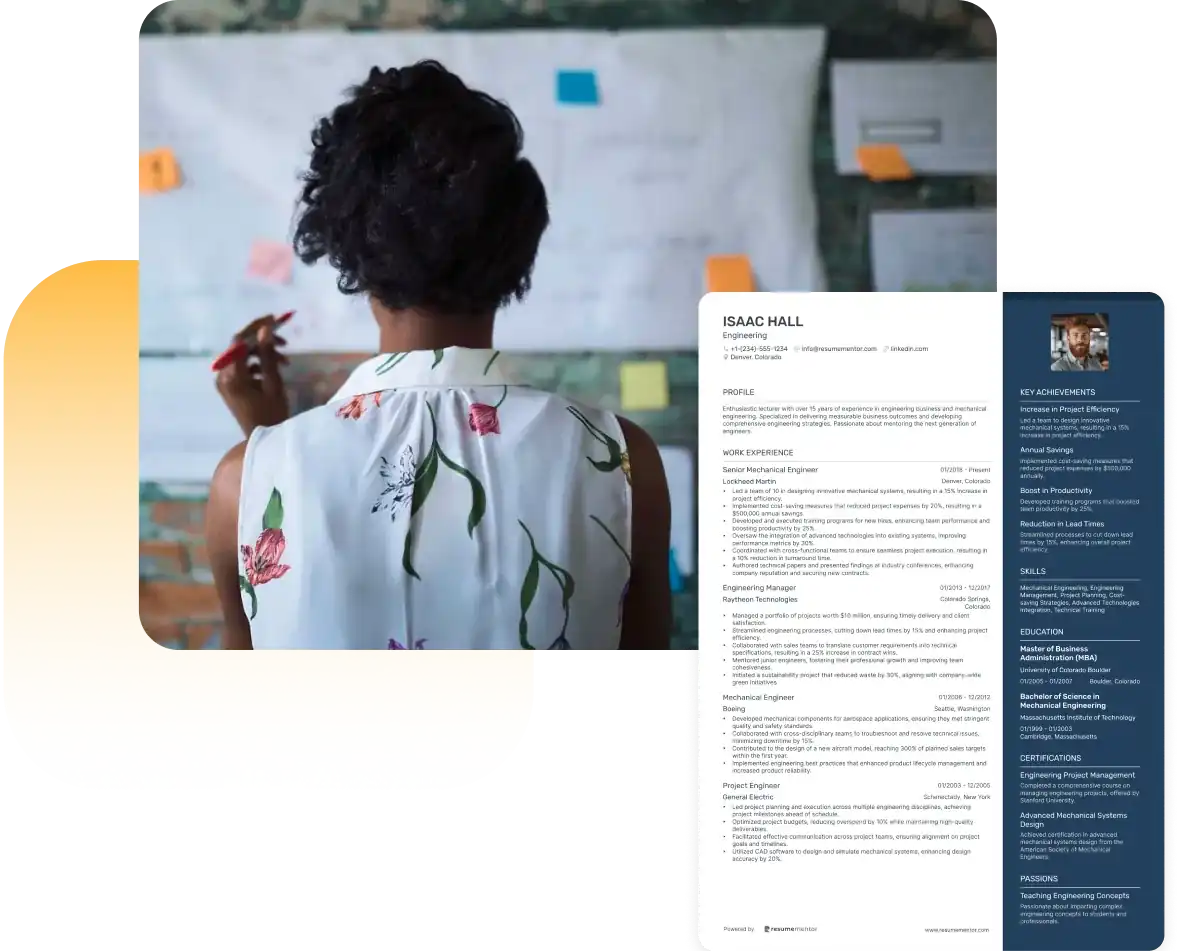
Continue Reading
Check more recommended readings to get the job of your dreams.
Resume
Resources
Tools
© 2025. All rights reserved.
Made with love by people who care.

